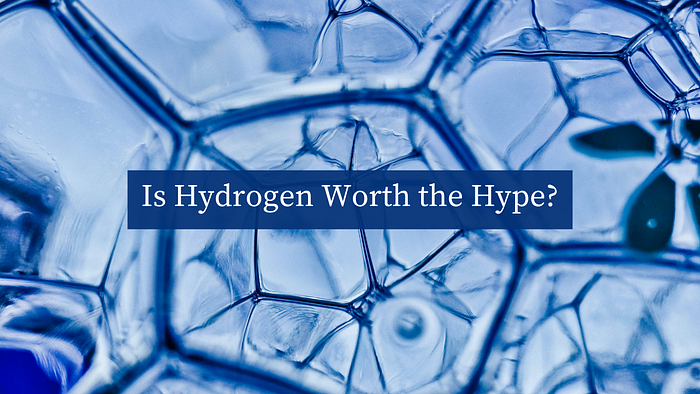Is Hydrogen Worth the Hype?
Hydrogen as a sustainable fuel has gained significant momentum over the past few years. The attraction of hydrogen is obvious — much of the world’s current energy use is built around liquid fuels (petroleum, natural gas), and replacing those fuels with a “clean” alternative sounds simple and appealing. Europe, in particular, has emphasized hydrogen in its plan to decarbonize its economy. Hydrogen is theorized as a solution to decarbonize cars, trucks, industrial processes, air travel, shipping, industrial vehicles, home heat, grid storage, and more.
However, will hydrogen be the best solution to decarbonizing these sectors? Let’s dive in and learn a bit more about the promise of hydrogen.
The Characteristics of Hydrogen: The Good and the Bad
Let’s start with a brief overview of hydrogen itself, to ground our discussion.
First, the good! Hydrogen burns “cleanly” — that is, when you burn hydrogen (to produce heat or electricity) the only byproduct is water. Additionally, hydrogen is energy dense, even more so than the world’s existing fuels. For example, by mass, hydrogen contains 3x the energy of gasoline.
However, hydrogen has some unique characteristics that make it challenging to use efficiently, and particularly challenging to retrofit to our existing infrastructure.
Challenges of Hydrogen as a Fuel
- Hydrogen must be stored at low temperature or high pressure
Hydrogen is a light (actually, the lightest) gas. 1 kg of hydrogen has about the same energy content as 1 gallon of gasoline. However, at standard temperature and pressure (aka on Earth), this 1 kg of hydrogen gas would take up 11 cubic meters of space — about the size of a large walk-in closet. So, if the gas tank in your car is 15 gallons, at standard temperature and pressure you would need a hydrogen tank the size of a small house to get equivalent energy! Therefore, to store enough hydrogen to be useful, you must either store it as a liquid (which requires very low temperatures, -400⁰F) or under significant pressure (~700 bar). Either of these approaches adds significant cost to using hydrogen.
2. Hydrogen is less efficient than renewable alternatives
Because hydrogen is a fuel (that must be produced, transported, and distributed), it is inherently less efficient “from sun to pump” than alternatives. Consider the graphic below, comparing two methods of using renewable electricity for transportation — hydrogen fuel cells and batteries. The “round-trip efficiency” of hydrogen fuel cells (how much of the original energy is used productively) is only ~25–30%, as energy is lost across production and transportation of the hydrogen.

This is inferior to electric batteries, which reach 70–90% in round-trip efficiency, primarily because the transport of energy in this case (through power lines) is very efficient. This creates an uphill battle for both the cost-effectiveness and the scalability of hydrogen.
3. Hydrogen doesn’t burn — it explodes
Hydrogen does not burn steadily like natural gas. Instead, it almost explodes. Therefore, you cannot just replace natural gas or gasoline with hydrogen without investing significantly in your equipment (for example, making electronics “explosion proof”).
4. Hydrogen corrodes pipelines
There is evidence that hydrogen corrodes existing pipelines (through a phenomenon called “hydrogen embrittlement”), even at very low concentrations. For example, see below a study on the effect of hydrogen gas on steel — even at 1% hydrogen, there is a meaningful decrease in fracture resistance.

This is an area where research is ongoing, but it creates challenges in using existing pipeline infrastructure to transport hydrogen.
5. Hydrogen leaks
Methane leaks have happened for decades, with limited visibility, but hydrogen is potentially much worse. It is the smallest molecule in the universe, and as such it is difficult to contain within traditional vessels or seals. Leaks have numerous downsides, both increasing the cost of delivered hydrogen and (in the worst case) creating a risk of explosion.
So, those are some challenges of hydrogen! However, many teams are working hard to optimize around these challenges, improving efficiency and reducing cost.
Let’s move onto the next challenge of hydrogen — is it renewable?
Supply of Hydrogen
Today, there are three main “types” of hydrogen — gray, blue, and green. Below, you can see a summary of these types of hydrogen.

A few observations are in order.
Gray Hydrogen: Gray hydrogen is produced through Steam Methane Reforming (SMR). In SMR, methane reacts with water, and produces carbon dioxide and hydrogen. Almost all hydrogen produced today is gray, and it is used in ammonia production and oil refining. This is “dirty” hydrogen (given the CO2 emissions).
Green Hydrogen: Green hydrogen is “clean”. It is produced by applying energy to “split” water into hydrogen and oxygen, with a device called an electrolyzer. However, today it is expensive, at $3–7.50 / kg (the wide range here is driven primarily by the cost of electricity).
Blue Hydrogen: Blue hydrogen is the “middle ground”. Blue hydrogen is gray hydrogen + carbon capture. It has a lot of benefits — it is close to being cost competitive with gray hydrogen today, it uses existing infrastructure, and it is theoretically carbon neutral. However, there is also controversy around blue hydrogen. Recently, a study came out purporting that the emissions reduction achieved by blue hydrogen would be offset by methane leaks. So, the full lifecycle benefit of blue hydrogen is an area of ongoing research.
Driving the cost of green hydrogen down is an area of significant research and investment. This will require building larger hydrogen production facilities and improving hydrogen electrolyzer technology.
However, this is an incomplete picture. The costs referenced above are production costs only. If you want to understand the true costs of using hydrogen, you must also include distribution costs — getting the hydrogen to where it is needed. As the data below shows, this can double the cost of hydrogen.

So, optimizing the delivery of hydrogen to where it can be used, efficiently, is also an area of ongoing research.
Use Cases of Hydrogen
Despite these challenges, there are people using hydrogen as a fuel today, and many more use cases being explored. Let’s look at these current and potential use cases, and see which ones make sense.
Note that in many potential use cases, we compare hydrogen versus other “clean” alternatives (for example, batteries, carbon capture + natural gas). This is because any discussion of hydrogen as a viable fuel implicitly assumes some level of mandate (either implicit or explicit) to move toward a net-zero economy.
With that disclaimer out of the way, let’s dive in!
Use Cases (Today)
Although hydrogen is used as a fuel today, it is not used at any scale.
Additionally, in many of the use cases where hydrogen does have some market penetration, battery electric has much greater penetration. Therefore, hydrogen is competing with another “clean” source of energy, and one that is on a steep cost curve decline. Consider the graphic below:

Although hydrogen has some penetration in forklifts and cars, battery electric vehicles have much greater penetration within these markets.
Finally, given the strong growth trajectory of battery electric supply chains, we expect batteries to continue to move down the cost curve quickly. As you can see below, batteries have reduced in cost by 97% over the last 30 years.

We wanted to compare this cost decline to the cost trend of hydrogen fuel cells. However, this is very difficult to do for a reason we stated before — there are just not many fuels cells manufactured today. So, most cost estimates on hydrogen fuels cells are theoretical — “if we manufactured 500,000 fuel cells, we think we could do it at $X”. So, you find a range of cost estimates in the academic literature. For example, here is a source from 2005 stating that fuels cells could be manufactured at ~$100 / kW, and here is a source from 2020 stating that fuel cells could be manufactured for anywhere from $50–110 / kW. So, there has likely been some improvement in fuel cell cost, but significantly less than the improvement we see in batteries. However, it is difficult to be precise.
Still, this lack of clean data just underscores the point — today, batteries are a much more mature technology than hydrogen fuel cells.
However, this is not just about today! So, let us consider the promise of hydrogen in other use cases.
Use Cases (Tomorrow) — Long Haul Trucking
One commonly predicted use case of hydrogen fuel-cell electric vehicles (FCEVs) is in long haul trucking. The reasoning here is as follows:
- Battery-electric trucks will have inferior range to hydrogen fuel-cell trucks
- Battery-electric trucks will require significant recharging time, which will further limit daily range
- Battery-electric trucks will require large and heavy batteries, reducing the cargo capacity of the trucks.
To test this reasoning, we ran some analysis based on current demonstrated technology from BEV and FCEV vehicles, to look at the relative cost of these two technologies in trucking. You can find this analysis below.

As can be seen, on mid-distance routes (daily distance of ~200 miles), BEVs look to be materially cheaper than FCEVs.
Where FCEVs have a potential advantage is in distances beyond the range of existing BEV technology. Because these are such large batteries, they can take significant time to recharge (on the order of hours). With this down-time, these BEV trucks will not cover as much distance in a standard ~11 hour driving day as FCEVs.
However, there is one caveat here.
There are several truck and battery manufacturers who are innovating on fast charging technology, building on improvements over the last 10 years. For example, Scania is planning on launching a truck in 2024 that can recharge in 45 minutes, and researchers at Ford just tested a cable that can charge an EV in 5 minutes.
If a large battery could be recharged efficiently in 30–45 minutes, this would erase the theoretical benefit of FCEVs (see the right of the graph above).
So, in summary — BEVs should outperform FCEVs in most trucking routes. With improvements in fast-charging, which have been happening quickly, this could become all routes.
Use Cases (Tomorrow) — Other
Outside of long-haul trucking, there are a wide variety of use cases under consideration. See below a summary of the potential for hydrogen in these use cases.

The use case for hydrogen that seems most promising is in steel. This is due to the relative dearth of other options to decarbonize steel, as steel production requires extremely high heat (which electric heat will have difficulty matching) and is not fully amenable to carbon capture.
Additionally, grid storage is worth discussing. Although from a techno-economic standpoint, hydrogen is not likely to be the best option to store energy for later use, it does offer one very compelling feature as a storage medium — it is transportable. So, you could see countries with access to overcapacity of cheap renewable electricity (wind, solar, hydro) produce hydrogen to export to countries with comparatively expensive electricity production. However, this is a very nascent market today.
In other markets, hydrogen either appears likely to be outcompeted by battery electric technology, or is one of a set of options (including synfuels and biofuels) that are being explored.
Final Observations
My view of hydrogen’s potential is “cautious skepticism”. We are early in hydrogen’s development as a widely used energy source, but at least today, in many use cases other “clean” technologies look more promising. Hydrogen faces many hurdles to adoption (reducing the cost of green hydrogen, building new infrastructure to use hydrogen), and even if it clears those hurdles, the inherent inefficiency of hydrogen as a fuel leaves it in an uphill battle against other options.
However, this is a quickly developing market, and I look forward to seeing how these views change over the coming years!









